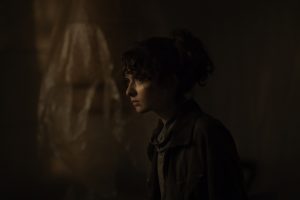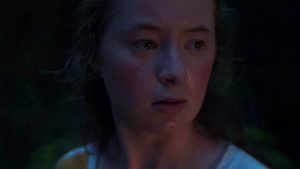Boston Underground Film Festival 2023 Recap and Review

I lined up at the little ticket booth outside the Brattle Theatre near Harvard, unsure of what to expect. My mind swam with images from the clean, modern precision of a very official event to the strangeness of mask-wearing, dim halls of an underground group. I guess it was my mind’s attempt to put the idea of “underground” together with “film festival” in a very haphazard fashion. What I found instead was a place of surprising warmth. Kind volunteers took my tickets. A little stand inside sold popcorn and drinks. And just upstairs from the lobby was a normal-looking theater full of many different types of people who were all chatting and finding each other amongst the seats. There was such a sense of community and heart that I was disabused of any of my previous notions. It was just a fun place full of passionate people. No wonder the festival has persisted for 25 years. The humanity of the place (which is ironic considering the festival’s genre is one of absurdism and horror) was a great mood setter to begin the nights of movie-watching. A lot of movie watching.
‘The Unheard’

The biggest event of the festival was on its opening night, which was the world premiere of a new horror film on Shudder: “The Unheard.” Following a deaf young girl named Chloe (played by Lachlan Watson from “Chilling Adventures of Sabrina”) as she prepares her old family home at Cape Cod for sale, the story reveals her as the subject of an experimental medical trial to heal her condition. Soon after the treatment, however, she begins to hear noises and a voice calling out to her: the voice of her missing mother. The sound design for the film is very impressive. Especially combined with the much-touted new surround sound system the Brattle Theatre installed ahead of the festival, the quiet and the loud, the glitched noises and voices, and the ringing all came out spectacularly. Sound, whenever there was any, was always oppressive in some way. It pressed against the skull through droning or muffling. Even though it did get a little too loud at times, the atmosphere created by the sound is perhaps the most terrifying part of the story. In the right scenes, it made my skin crawl.
The story, however, is more of a mixed bag. Perhaps the film’s biggest flaw is in unnecessary and undeveloped characters. For example, the main character, Chloe, has a childhood friend named Josh. He plays an important role in the story, concretely revealing the presence of the supernatural and later helping Chloe defeat the antagonist. Beyond those actions, however, who Josh is and how he connects with Chloe is unexplored, turning him from a character to a plot device. Another example is the doctor who helped Chloe with the medical trial. The film attempts to explore how Chloe relates to others and tries to give Chloe a human side by having a supportive and grounding companion. Even though the doctor plays a more prominent role, it’s hard to feel like the relationship matters.
Everything, from the villain to Chloe’s family background to her relationships is overshadowed by the tension with the atmospheric sounds and the mystery it creates. The story feels somewhat incomplete as a result. Lachlan Watson’s Chloe is the most interesting of the characters. There is real-time spent on her, giving the audience a better sense of who she is, and Watson brings about one of the better-acted characters in the film.
Overall, despite the great atmosphere and the beautiful use of sound, the story runs into trouble through its lackluster characters and underdeveloped plot. Sound as a main horror device is not usually used in the visual medium, so if you’re looking for a real moody and audibly immersive film, check out “The Unheard” on Shudder.
‘Nighstsiren’

The second film of the night was “Nightsiren,” a Slovakian film directed by Tereza Nvotová, who also co-wrote the movie along with Barbora Namerova. Split into multiple chapters, the film follows Šarlota, a woman from rural Slovakia who escapes her abusive mother as a child. During the escape, however, she accidentally pushes her younger sister Tamara off a cliff. Thinking that she had killed her sister, Šarlota does not return to the place she grew up in until a government summons about inheriting her mother’s things shows up at her door.
The film is first and foremost beautifully shot. For a film about the backward beliefs of rural areas and the old fear of witches, the rustic cabins and sprawling forest landscapes set the tone perfectly. Most beautifully done is the nighttime. Night serves different purposes in the movie from oppressive darkness to chilling and calm. In each scene, the way light and framing are used draws forth the right characteristic of the darkness for the story. The acting is also quite good in that it’s raw and not too dramatic. Perhaps due to the fragmentary structure of the story, though, the film suffers from inconclusive plot lines.
The only conclusive thing about the storyline is the main theme, which is the feminist perspective on the old patriarchal systems, as told through the fear of witches throughout the story. One scene shows women being ceremoniously whipped and squirted with water. Šarlota and her newfound friend Mira are the victims of drenching in the lake neither of them wanted. When Šarlota’s struggles make her accidentally kick a child, the characters accuse her of not being a good sport in the endeavor. In the various misogynistic criticisms, however, the dialogue is a little stilted. There is nothing subtle about people’s condemnations, which ends up making the misogyny feel somewhat forced.
The story’s end is what the feminist theme builds up to, with Šarlota and Mira being accused of witchcraft and the townsfolk intent on harming them. On the other hand, plot threads such as Tamara’s fate, the potential existence of real magic, and Šarlota’s traumas are left loose. All of them have an impact on the story of feminism, but they do not work closely with it. Their inclusion in the story seems like an unnecessary addition that ends up pulling the thread in so many directions it weaves something unfocused.
Regardless, the story is solid for the most part. Including the acting and the cinematography. The film is worth a watch, especially if you want to catch some sense of witchiness in the forest. The evil, of course, is ultimately of a mundane source, but the satisfyingly strange and unusual looms throughout the whole film.
‘Stand by for Failure’

This film was the first documentary of the festival. It focuses on Negativland, a band that plays a cacophony of sounds, messing around with electronics and various sample tracks until they make something very strange but somehow attractive for the ear. It details the growth of the band, from their earliest successes in broadcasting their weird music and getting new band members through spontaneous discovery of their work to their studio burning down; from people claiming their song “Christianity is Stupid” inspired a 16-year-old to murder his family to the deaths of the band members through age and time. Even in death, they had their own way of managing it. One of their friend’s cremated ashes was divvied into small plastic bags and sold with new records.
The best part about the documentary is that it uses interviews from different decades. It makes the audience live through the times with them because it was honestly easy to forget they aren’t that young anymore. The documentary took their moments and made those moments timeless. It makes the development of the story that much more engaging because of the sympathy the audience gets by seeing this band grow up and grow old. One does not realize that some of these people full of vitality and humor in colored videos have died or are hospitalized. But the documentary is not just a soup of sadness. It celebrates the band by listening to the musicians behind it — these quirky lovers of sound in all forms just enjoy what they do. The human aspect of it, especially in the face of all the disapproval the band got from society due to their unusual style, makes the legacy they leave in some performances they do even today that much more satisfying to see.
The only thing the documentary suffers from is some aloofness. Sound is featured prominently in the film, and the music/sounds of all sorts of strange kinds play almost as much as the dialogue. The film likes establishing a sense of things before letting the dialogue deliver an emotional blow or triumph. The issue is that it’s not always clear what the documentary is trying to get at, and in extended sections where only music plays, it lulls the viewer to relegate the film into the background. There are moments when I wanted to close my eyes and nap, but not because it was boring. It’s just that a lack of something to grasp my attention combined with what my brain finds eerily similar to white noise made me…overly comfortable.
Still, though, it’s a rather wonderful documentary to watch. Especially in the second half, the film really picks up and delivers all the emotions. I was fully paying attention by then. It tells a fascinating story that is not told often, and it is an inspiring story for artists placing their vision into the world. If documentaries are your thing, I definitely recommend giving it a watch.
‘Spaghetti Junction’

“Spaghetti Junction” is an independent film from top to bottom. Having a small budget, the only official set piece for the film is the home that the main character, August, endures. As director and writer Kirby McClure revealed during the Q&A session after the screening Thursday night, many of the film’s locations were shot without official permits. Despite that, the film managed to capture beautifully the scenery around Atlanta, where the titular Spaghetti Junction is located.
The film is well-acted for the most part. It’s both an attestation to the writing and the acting that the characters were nuanced when it comes to morality. More importantly, it carefully tackles how able people deal with those with disabilities. The story is missing important bits, however. There are many plot lines and characters that don’t get the resolution they need. It’s very unfortunate that with such an intricate initial setup about the complexity of a family dealing with trauma never delivers on what the story promises.
It starts in a troubled home with an alcoholic father, an older sister named Shiny with a bad boyfriend, and a newly disabled August who has to navigate through them all. August’s interaction with Shiny and her father initially promises something very subtle. There is anger and jealousy pointed towards August for her wounds from every side, but at the same time, they still take care of their own, even if it’s more out of a sense of duty (like when Shiny promises her father to include August even though she didn’t want to). It results in half-hearted attempts to care for August that ultimately leaves her feeling more ignored than loved. But the film doesn’t latch onto that. Instead, it heads in two big directions.
One direction is the storyline of Shiny and her boyfriend planning to abandon the family. This direction distracts from the central idea of how August is treated by her wounded family. It’s an interesting direction, but it takes up the space needed for the main point. The other storyline is the encounter between August and an alien who crashed into Earth. The alien, called the Traveler, needs to find his way home to save his people, and August helps him. They develop a bond, and the intention is to inspire August to not feel lesser for her condition. This direction is also interesting, but the Traveler and August’s relationship doesn’t provide the moments for that growth. The plot focuses on the Traveler’s way home, and August’s story is left in the dust.
Every single thread could have been a great story, but squishing them together and not focusing on any one of them makes me feel like the film was cut down from something many times longer. Despite it all, of course, the story tackles important subjects through sci-fi in a way I’ve never seen before. The movie has its moments that very much let me feel how complicated people are.
‘Smoking Causes Coughing’

Quentin Dupieux is back again with another off-the-rails comedy. This time, the story focuses on a group of superheroes called the “Tobacco Force” and their retreat into the mountains to rebuild their team spirit. Plenty of people turned up for this film. The Brattle Theatre was more packed than it was for a few other screenings. Everyone was ready with a hearty laugh or chuckle.
The film doesn’t disappoint on the comedy front. We were immediately greeted with the sight of a purposefully low-budget bug monster exploding into blood and guts, all of which got flung into the faces and bodies of a spectating family. And in case you’re wondering, no, the film does not incentivize smoking despite the team’s strange name. They tell the blood-covered and excited child of the family that his father was stupid because he smokes.
Stupidity becomes the film’s central focus. Suicidal robots, sexual attraction to sewer rats, and low-budget superhero costumes are all featured in the work. This is the film’s best aspect, where it mixes an almost wholesome dumbness with excessive violence. One story shown in the film (as told by a character) is one where a woman puts on a helmet that isolates the user from the world. She descends into madness as she realizes how much she hates the people she is with, and she kills them all, all while nonchalantly wearing the same, ridiculous-looking helmet. It’s bonkers.
But randomness is also where the film ends up faltering. New comedic bits are thrown about constantly, but they don’t lead to anything. These beyond-temporary-gags take up significant time from the plot and don’t do anything with the fundamental idea of team-building. Now, this isn’t necessarily a mistake. Not taking anything seriously shows the point of the story can be one of meaninglessness (after the Monty Python fashion). The heroes are stupid. The stories are stupid. None of it matters. That is an interesting post-modern take on superhero movies or the fears drummed up by the media. But the danger ends up being making a film that people don’t care about because none of it matters instead of making the pointlessness the satirical point. Whether the movie succeeds or not, you’ll have to see for yourself. I will say, plenty of people were laughing all the way through it.
‘Sick of Myself’

“Sick of Myself” is probably the most horrifying film I watched for this festival, and it isn’t even a horror film. Following two self-absorbed people in a relationship, the film is about one woman’s attempt to overshadow her boyfriend’s burgeoning career through self-harm by taking illegal pills, knowing that they would cause her severe medical issues.
It made me at the same time cringe at the character and feel pity for her. The best thing the film does is show where this narcissism comes from — a deep sense of self-hatred. It’s hard to watch as the main character, Signe, plummets down this hole of her own volition. And through her many fantasies, it’s revealed that all she truly wished for was for people to have loved her. Now, the horror element comes from the wonderfully chosen method of harm, which is this illegal drug with proven disfiguring side effects. Any other form of self-harm has mostly predictable results. A vicious dog bite might cause disfigurement or infection, but wounds are understandable. What is not understandable is the seemingly mysterious effects the drug has beyond the warnings online. Signe chose it for its known properties, but she finds out that it does so much more. From hair loss to throwing up blood, the film creates a long, drawn-out fear for the main character’s safety. And because the danger comes from herself, there is a terror in the fact that one’s brain can mislead them. In a modern age where mental health is more visible, this one will strike a nerve with many.
The film, in its way, is also very comedic. It’s not one of those dramatic and sad storylines. Some of the character actions are just so stupid that one can’t help but see their absurdity. When I was not filled with pity, I was chuckling in disbelief. It makes the film not so dark overtly. The comedy successfully shrouds the painful undertones of the story and lets the audience feel those undertones in the background, acknowledging both the absurdity and horror of dealing with a turncoat mind.
I strongly recommend watching this film, but be warned. It can be hard to stomach watching someone ruin their own life. It’s a good character study; it’s well-shot, acted, and written. Kristoffer Borgli, the writer and director, did a fantastic job.
‘Piaffe’

And finally, there is “Piaffe.” It is a story about a woman who discovers her confidence while she tries to fill in her sibling’s shoes at a sound design job. Throughout the story, she finds a horse tail growing out of her. “Piaffe” will be distributed by Oscilloscope Laboratories later this year in theaters. It’s a fascinating story, so watch out for that!
